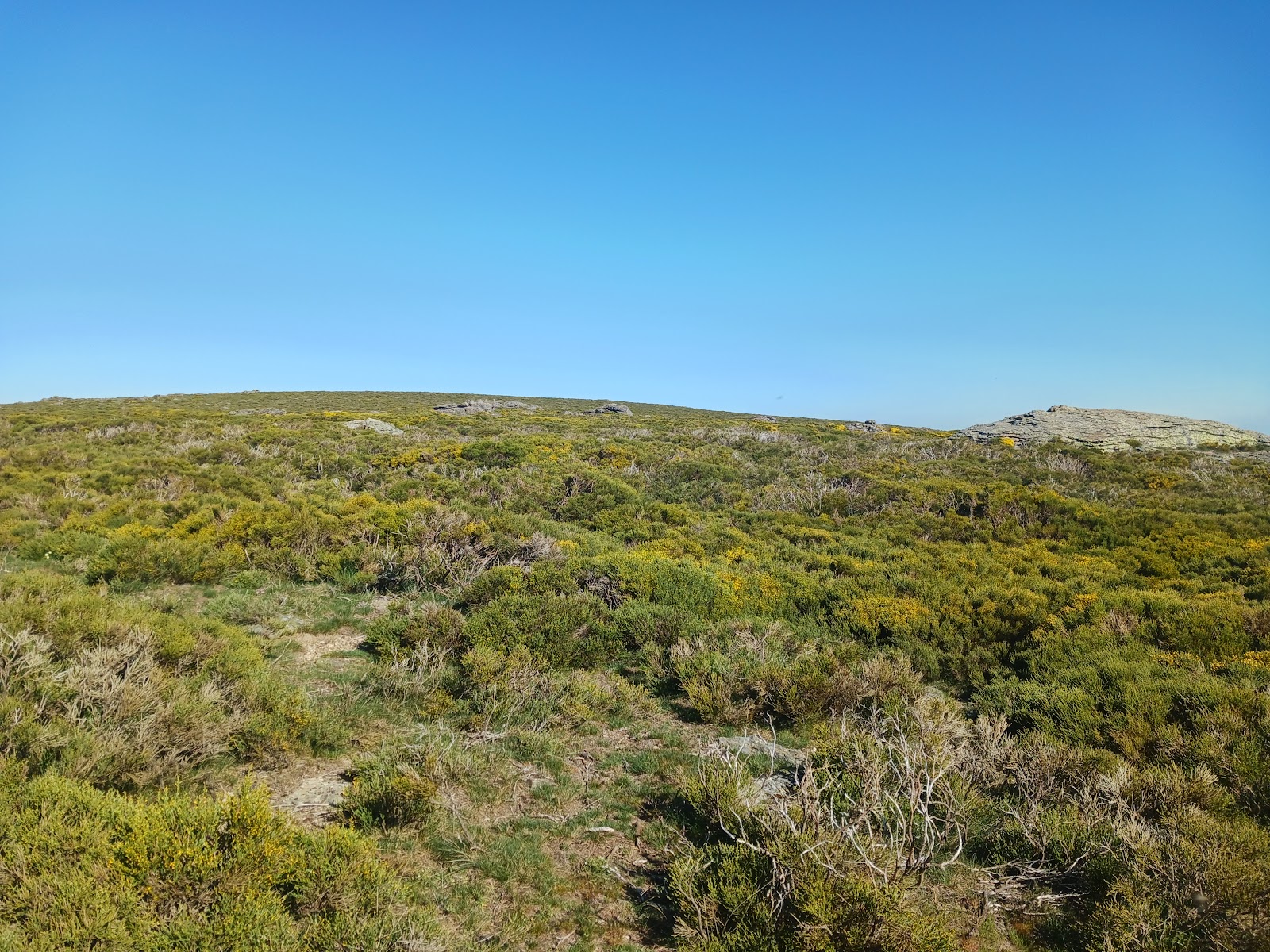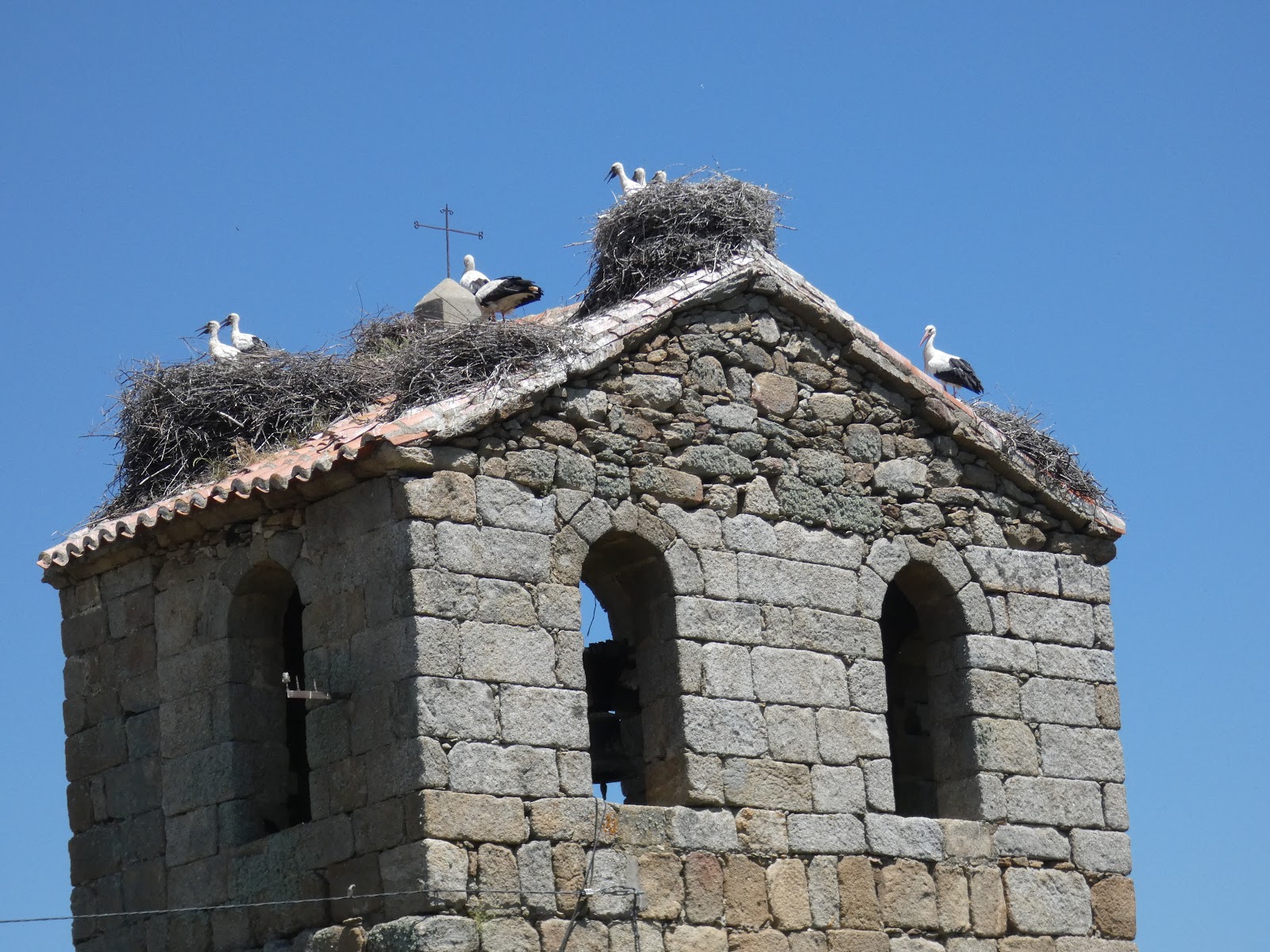With a heatwave raging in most of Spain, I was very happy that my itinerary had me heading up to the sierras after leaving Monfrague. I also planned to search for some lower elevation species that were likely commoner on the greener northern side of the sierras.
My initial foray was to be up into the Sierra de Bejar. This far south, most of the ‘alpine specials’ found in the Pyrenees, such as Alpine (Yellow-billed) Chough and Wallcreeper, don’t occur. In fact, the only classic montane specialty was (Rufous-tailed) Rock Thrush. However, there were quite a few birds of interest, headlined by the Iberian race of Bluethroat.

Subalpine heath in the Sierra de Bejar
After a failed attempt to check into my hotel, where the automated check-in failed to work (I ended up unplugging it to make sure someone would have to call the owners), I drove up to the ski resort on the mountain top. The last KM or so were fairly flat and consisted of a broom-based heathland, interspersed with damp grazed meadows. At the ski resort itself, the ground sloped up again with some rock outcrops and boulder slopes.
Getting out of the car I immediately heard a (Greater) Whitethroat singing and saw the first of numerous Dunnocks. Based on their habitat choice in Spain, Subalpine Accentor would be a good name for them! It was easy to see how the Dunnock-like Japanese Accentor was a montane species. I eventually had so-so views of a Bluethroat, that appeared to lack any spot in the throat, but it vanished and I failed to refind it. Further efforts drew blank, but I did get several views, some excellent, of Tawny Pipit, one of my target species. Various raptors came by, including Cinereous Vulture, Eurasian Vulture, Peregrine and Booted Eagle.
I began to check out some of the more rocky areas for Rock Thrush but could only come up with Northern Wheatears and Black Redstarts. Descending back down towards the car park, I noticed a bird perched up on the ski resort building – a male Rock Thrush! I was able to get nice looks by varying my viewing angles a bit. Further searching lower down failed turn up any Bluethroats, but I did find a couple of Water Pipits.
I returned to the hotel and checked-in without a problem this time. The next morning I headed back up to the tops, determined to get better looks at a Bluethroat, as well as finding a couple of other desired birds. Even in the early morning, the Bluethroats proved surprisingly elusive and I took me almost two hours and some serious thrashing through waste-high broom to get quality views. I also saw one of the my other targets – a male Red-backed Shrike – although the bird was a little distant.

Bluethroat perched in a broom bush
At this point, I began to look for Ortolan Bunting, which also occurs in this subalpine heath habitat. Needless to say, I could not find one to save my life, while Bluethroats were now popping up everywhere! I eventually ended up with no less than seven Bluethroats, which varied between showing large white throat spots to none at all. I noted several Dartford Warblers as well, with the broom obviously an a perfect substitute for the gorse heathland they utilize in the UK.
After trying a little playback for Ortolans, I immediately realized that the Yellowhammer-like song I had heard while driving up was likely from an Ortolan. Driving back down the mountain with the car windows open, I heard the bird singing again. Soon after parking, I got good looks at a male Ortolan, finding a second male shortly afterward. I also obtained better looks at a male Red-backed Shrike as well as a couple each of Wood Lark and Common Cuckoo, including a hepatic-morph female.
The final species I was looking for was (Western) Bonelli’s Warbler. Descending further, I reached the belt of deciduous woodland on the lower slopes of the mountains. After some searching, I found a singing male Bonelli’s Warbler that showed well. Unfortunately, a singing Golden Oriole proved as elusive as the birds heard earlier in the trip.
At that point, I began the drive towards the Sierra de Guadarrama, north of Madrid. En route, I wanted to try for Cirl Bunting and Wryneck. I had chosen the area around Junciana for these species. A couple of miles before I reached the turn to Junciana, I noticed an old orchard on the edge of a village. Since Wrynecks are often found in such habitat, I parked nearby and gave a couple of short bursts of playback. I was pleasantly surprised when a Wryneck almost immediately flew into a nearby tree and gave good views. Taking a stroll down a nearby side road failed to turn up any Cirl buntings but did produce even better views of another Wryneck. Another stop along a pleasant riparian strip yielded a few common species such as Bee-eater and Gray and White Wagtails.

Nesting White Storks
The rest of the drive to the Guadarramas featured numerous nesting White Storks, while Red Kites proved to be much more numerous along the north slope of the sierras than further south. Reaching my hotel in Cercadilla, I took it easy for the rest of the evening.
The next morning, I headed up to the ski resort at the Puerto de Navacerrada with the goal of finding a Citril Finch. I had seen this species previously in the same mountains, but ebird data suggested that my chances were only around 50/50. I concentrated on areas where the pine forest met open meadows or heathland. Most of the birds were Chaffinches, Coal Tits and Black Redstarts but I did find a pair of the Iberian race of Pied Flycatcher that has more extensive white in the wing compared to those in the UK and a pair of Crested Tits. After hearing what appeared to a fly-by Citril Finch on the outbound part of my hike, I detected the bird again on the return and was able to get a decent look at the front half of a male perched in a pine. However, further efforts to obtain better views proved fruitless. I then trekked up the mountain to the top of the ski lift as some recent photos of a Rock Sparrow from the area indicated it was perching on some kind of cable. Frustratingly the only sparrow calls I could hear upon reaching the ski lift building were from inside the building and birds showed no sign of emerging.
At that point, I decided to drive to a wetland area close to the airport so I would be in a better position to pick up Paul when he arrived. This proved to be a great move, as I saw a nice male Ferruginous Duck there and a male Penduline Tit. A Ruddy Shelduck was also present, but I am sure sure if it was a feral bird or not.
Dropping by a supermarket to pick up some supplies, I experienced a bit of drama when for some reason the automatic gate in the super market parking structure would not let me out, claiming that I had exceeded the free parking period – which I had most definitely not. Eventually I got in close behind another vehicle and followed it out before the gate could come down!
Comments
Post a Comment